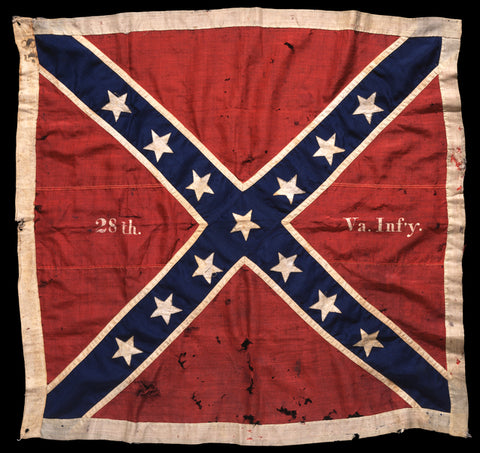
‘Why? I mean, we won’: The Century-Long Battle Over This Confederate Flag
Nearly 160 years later, a fight remains between the North and the South and it’s not over state’s rights or slavery. It’s over a flag.
“This is a story about one of those intense little ghost battles that continue to spin off from the Civil War because so much remains unresolved,” writes Kathy Sawyer for the Washington Post. “The objective of this struggle is a scrap of wool bunting that rests in a vault at the Minnesota Historical Society. Between its origins on the hides of 19th-century sheep grazing somewhere in the British Isles and its current repose in St. Paul, this bit of cloth was carried by the 28th Virginia Infantry Regiment to the ‘high-water mark’ of the Southern rebellion one hot and bloody July day at Gettysburg.”
The flag, issued to George Pickett’s division of the Army of Northern Virginia, saw its first and last taste of combat after Pvt. Marshall Sherman from the 1st Minnesota took the flag away from Lt. John Abbott Independence Lee from Virginia.
Both Sherman and Lee were participants in Pickett’s famed, yet catastrophic charge that led to nearly 90 percent casualties on the Confederate side.
"We just rushed in like wild beasts," one Minnesotan fighter, William Harmon, described. "If men ever became devils that was one of the times… We just rushed in like wild beasts. Men swore and cursed and struggled and fought, grappled in hand- to-hand fight, threw stones, clubbed their muskets, kicked, yelled and hurrahed."
Amid the “confused, tangled, excited, deadly mass” Sherman emerged with the flag of the 28th. Accounts of how Sherman gained possession of the flag differ, however.
According to the Post, Sherman told the Roanoke Times __ years later that he had run straight at the flag bearer until his bayonet-tipped rifle was inches from the man's chest. "Throw down that flag or I'll run you through, " he commanded.
When Lee hesitated, Sherman once again repeated the order, and the lieutenant dropped the flag and was taken prisoner.
Pvt. Daniel Bond, also of the 1st Minnesota, recalled the moment differently. The flag was already resting, unclaimed, against a tree, he said, and the capture was more of a foot race that Sherman won and he, Bond, lost. "The rest of the flags were gobbled up by other soldiers so that out of the 28 stands which were taken by our corps," Bond said, "I did not get a rag."
Whether from the threat of bayonet to the chest or a foot race, Sherman was awarded the Medal of Honor for his efforts in winning the flag.
Since that hot and chaotic morning on July 3, 1863, there have been many calls for Confederate flags to be returned to their home states, and in particular for the 28th Virginia Infantry Regiment flag to return home to its home state.
In 1887, President Grover Cleveland issued an executive order to return the colors of a few Confederate units as an act of good will. His order was largely ignored, with former Confederate president, Jefferson Davis, even scoffing that banners belong to the captors, by "all known military precedents," writes The Atlantic.
In 1998, the banner was once again raised to bring the flag “home” when Chris Caveness, a Roanoke resident, spearheaded a federal lawsuit citing a 1905 act of Congress allowing for the return of Confederate flags in possession of the War Department.
Caveness told the Roanoke Times that “‘federal property cannot be abandoned or disposed without Congressional assent.’ Since Congress never gave the flag away, former Virginia Attorney General Anthony Troy concluded, Minnesota is illegally in possession of it.”
In 2000, members of the Virginia General Assembly requested the return of the flag. Once again, the request was denied with then-governor Jesse Ventura stating, “Why? I mean, we won.”
Repeated calls in 2002, 2003, 2010 and once again in 2013 for the 150th anniversary of Gettysburg for the flag’s return. All such requests have been denied.
historynet magazines
Our 9 best-selling history titles feature in-depth storytelling and iconic imagery to engage and inform on the people, the wars, and the events that shaped America and the world.
